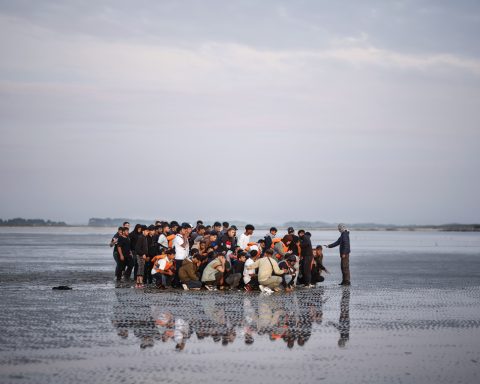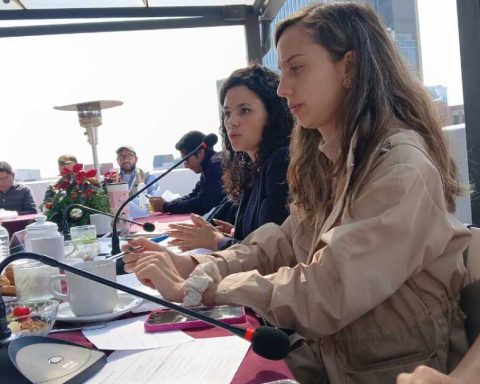Temperatures above 30 degrees were registered this Monday in more than half of the country’s surface, with a 41.2 degree peak in the city of Rivadavia in Salta, while alerts for intense heat are in force in various provinces of central and northern Argentina, reported the National Metereological Service (SMN).
According to the update of the SMN temperature ranking at 6:00 p.m., second place was occupied by La Rioja, with 39.2 degrees, followed by San Ramón de La Nueva Orán, Salta, with 38.9.
These localities were seconded by Chamical (La Rioja) with 38.5 degrees; Villa Reynolds (St. Louis) with 37.9; and Santiago del Estero with 37.8.
In Santiago del Estero, it is expected that by “the end of December, January and part of February, temperatures will be above normal,” engineer Howard van Meer, in charge of INTA’s provincial delegation of Agrometeorology, told Télam on Monday.
The specialist commented that these temperatures that have been recorded so far in that province “are not extreme, it is hot, but not like the one we had in January of this year, with 46 degrees; they are temperatures that are measured in the box in the shadow, but it is understood that, above all, in the cement it is much higher”.
He also explained that “the effect of La Niña continues and, therefore, there will be a high probability of clear days, less rainfall, more sun and more temperatures.”

In turn, temperatures above 37 degrees were recorded in some towns in Córdoba, San Juan and Formosa.
High temperatures were also reported in Laboulaye (Córdoba) with 36.6, Presidencia Roque Sáenz Peña (Chaco) with 36, General Pico (La Pampa) with 35.3, Termas de Río Hondo (Santiago del Estero) with 35.2.
In addition, in Ceres (Santa Fe), Marcos Juárez and Río Cuarto (Córdoba) 35.8 were registered, and in San Miguel de Tucumán (Tucumán) 33.4.
In the province of Buenos Aires, the highest temperatures were located on 9 de Julio with 35.5; Lauquen train with 35.4Pehuajó with 35 and Bahía Blanca with 34.2.
In this context, the company Aguas Bonaerenses SA (ABSA) reported that “due to the high consumption of water that is being recorded as a result of the high temperatures that plague a large part of the province of Buenos Aires, it is imperative to take extreme care of water, prioritizing instances of hydration”.
It was indicated that, although all of the instances that make up the drinking water service are operating in their entirety, the service may suffer in some sectors of the more than 90 localities in which it is provided.
In Bahía Blanca, ABSA began with a contingency plan for alternative assistance with drinking water for that city and Punta Alta, given the increase in supply demand.

“The operation includes the availability of tankers of 10 and 30 cubic meters, fixed cisterns and delivery of drums,” said the company.
In addition, the SMN reported this afternoon on its Twitter account that maximum temperature records were recorded for November in the Patagonian towns of El Bolson with 34.2°Cwhose previous record of 33.5°C occurred on November 19, 2020; Bariloche with 32.5°C, whose highest temperature for this month was 31.5°C in 1985 and Esquel with 30.5°, whose previous record was 30.2° in 2020.
Meanwhile, in San Luis, a red alert is in force – the maximum issued by the agency – for the lower areas of Belgrano and General Pueyrredón, which includes the capital city, as well as in the Cordovan departments of Río Primero, Río Segundo and Tercero. Up.
In that province of Cuyo, the high temperatures registered during the weekend were accompanied by cuts in the supply of drinking water in different neighborhoods of the capital city.
In response to the provincial water context, San Luis Agua announced that it has hydrant trucks for users and that the assistance is intended for areas where raw water systems cannot provide the necessary water flow to supply all users. to more than 50 towns and places in the province, it was officially reported.
⚠️The max temperature records for November continue ?️
Data for Sunday in #Patagonia– EL BOLSON 34.2°C (previous 33.5°C, 11/19/2020)
– BARILOCHE 32.5°C (previous 31.5°C, 11/29/1985)
– ESQUEL 30.5°C (previous 30.2°C, 11/19/2020) pic.twitter.com/xhs10TowXT— SMN Argentina (@SMN_Argentina) November 28, 2022
The SMN also issued a red alert for heat for the cities of Rosario, Constitución, Iriondo, San Lorenzo, Caseros and General López, in Santa Fe; for the towns of Gualeguay and Victoria, in Entre Ríos, and for Baradero, Ramallo, San Nicolás and San Pedro, in the north of Buenos Aires.
This warning means that high temperatures can affect everyone, even healthy ones, so it is recommended to increase water consumption, avoid excessive sun exposure and avoid eating large meals.
In Santa Fe, the company Aguas Santafesinas SA (Assa) requested today “a responsible and supportive use of drinking water” due to the high temperatures that will continue in the region at least until Thursday, and that are already causing supply problems in the northern neighborhoods of the provincial capital.

The state-owned company said today that “the water treatment plants are working at 100% of their capacity,” with which they called to “avoid secondary consumption of drinking water, using what we essentially need, but without wasting “.
With an orange alert, the entire province of Catamarca is located, east of Las Heras, La Paz, Lavalle, San Martín and Santa Rosa (Mendoza); Juárez Celman and the lower area of Río Cuarto (Córdoba); and Florentino Ameghino, General Villegas and Rivadavia (Buenos Aires).
In San Juan, Salta, Tucumán, Santiago del Estero, La Rioja and several towns in Mendoza, Neuquén, north of the province of Buenos Aires, south of Córdoba, a large part of La Pampa, Entre Ríos, Corrientes and San Luis, a yellow alert is in force .


















